Practice-Based Public Health Profile: Dementia Strategy in Barnet
VerifiedAdded on 2020/12/18
|10
|3115
|82
Report
AI Summary
This report provides a comprehensive practice-based public health profile of dementia within the London Borough of Barnet, with a specific focus on the BME (Black and Minority Ethnic) groups. It details the prevalence of dementia in this population, highlighting observed health inequalities and the social determinants contributing to the issue, including economic stability, education, and social context. The report identifies key public health policies and services available in Barnet, such as policies aimed at empowering those with dementia, and services provided by the Barnet Council and Barnet Clinical Commissioning Group. It also discusses the practice area profile within a mental asylum, including the demographic context, mortality rates, and trends of morbidities in the area. The report further explores areas for intervention and service improvement to address the challenges faced by dementia patients in the community.

Practice-Based Public Health
Profile and Strategy
Profile and Strategy
Paraphrase This Document
Need a fresh take? Get an instant paraphrase of this document with our AI Paraphraser
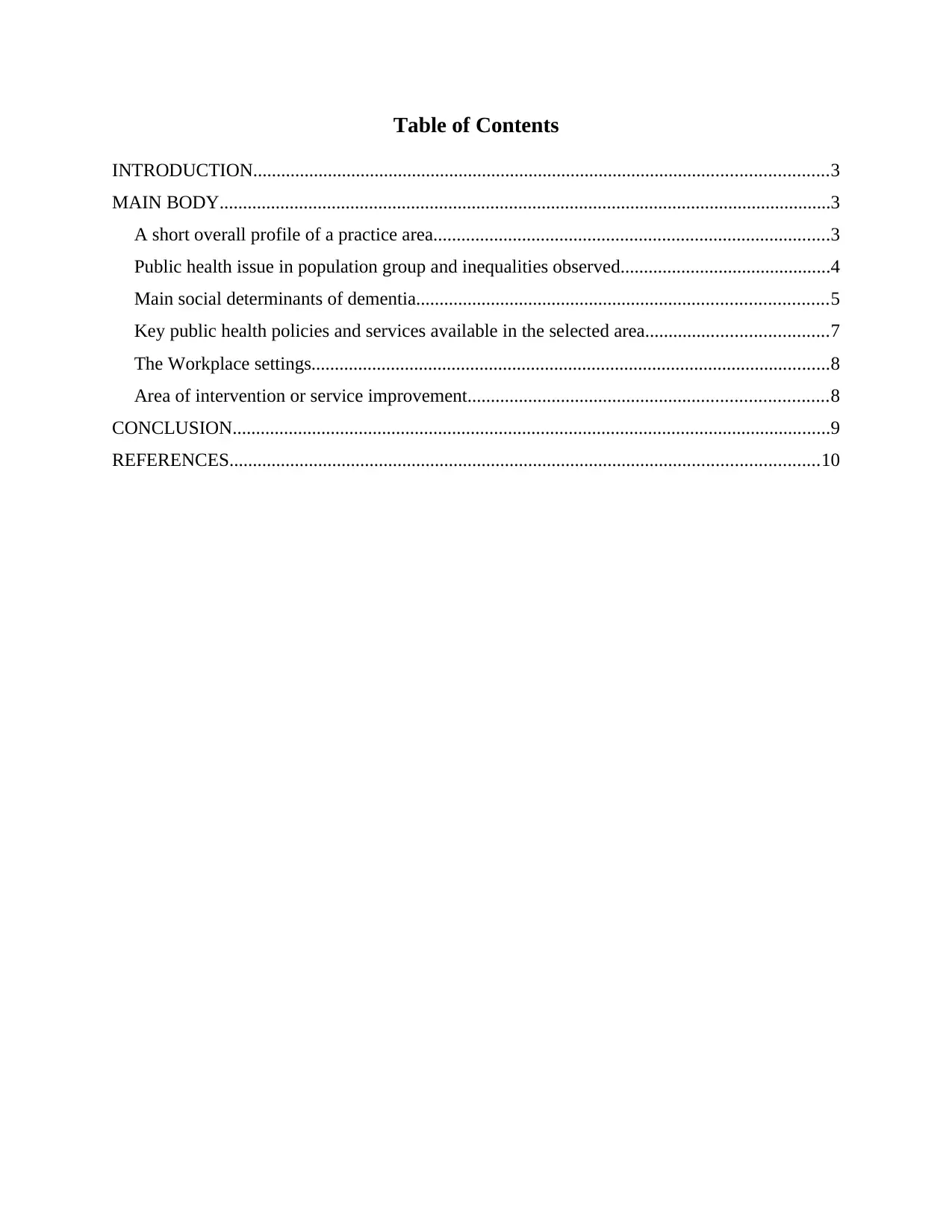
Table of Contents
INTRODUCTION...........................................................................................................................3
MAIN BODY...................................................................................................................................3
A short overall profile of a practice area.....................................................................................3
Public health issue in population group and inequalities observed.............................................4
Main social determinants of dementia........................................................................................5
Key public health policies and services available in the selected area.......................................7
The Workplace settings...............................................................................................................8
Area of intervention or service improvement.............................................................................8
CONCLUSION................................................................................................................................9
REFERENCES..............................................................................................................................10
INTRODUCTION...........................................................................................................................3
MAIN BODY...................................................................................................................................3
A short overall profile of a practice area.....................................................................................3
Public health issue in population group and inequalities observed.............................................4
Main social determinants of dementia........................................................................................5
Key public health policies and services available in the selected area.......................................7
The Workplace settings...............................................................................................................8
Area of intervention or service improvement.............................................................................8
CONCLUSION................................................................................................................................9
REFERENCES..............................................................................................................................10
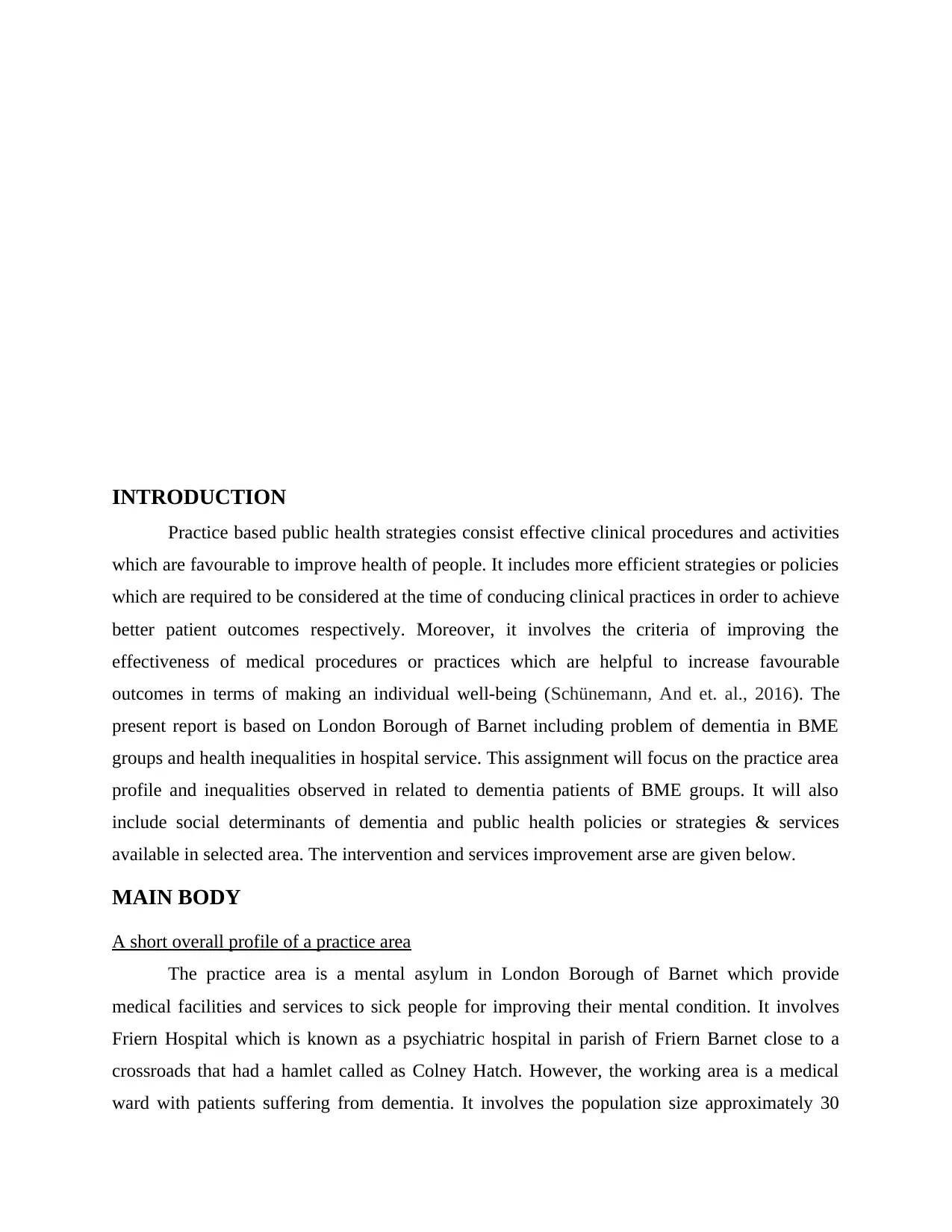
INTRODUCTION
Practice based public health strategies consist effective clinical procedures and activities
which are favourable to improve health of people. It includes more efficient strategies or policies
which are required to be considered at the time of conducing clinical practices in order to achieve
better patient outcomes respectively. Moreover, it involves the criteria of improving the
effectiveness of medical procedures or practices which are helpful to increase favourable
outcomes in terms of making an individual well-being (Schünemann, And et. al., 2016). The
present report is based on London Borough of Barnet including problem of dementia in BME
groups and health inequalities in hospital service. This assignment will focus on the practice area
profile and inequalities observed in related to dementia patients of BME groups. It will also
include social determinants of dementia and public health policies or strategies & services
available in selected area. The intervention and services improvement arse are given below.
MAIN BODY
A short overall profile of a practice area
The practice area is a mental asylum in London Borough of Barnet which provide
medical facilities and services to sick people for improving their mental condition. It involves
Friern Hospital which is known as a psychiatric hospital in parish of Friern Barnet close to a
crossroads that had a hamlet called as Colney Hatch. However, the working area is a medical
ward with patients suffering from dementia. It involves the population size approximately 30
Practice based public health strategies consist effective clinical procedures and activities
which are favourable to improve health of people. It includes more efficient strategies or policies
which are required to be considered at the time of conducing clinical practices in order to achieve
better patient outcomes respectively. Moreover, it involves the criteria of improving the
effectiveness of medical procedures or practices which are helpful to increase favourable
outcomes in terms of making an individual well-being (Schünemann, And et. al., 2016). The
present report is based on London Borough of Barnet including problem of dementia in BME
groups and health inequalities in hospital service. This assignment will focus on the practice area
profile and inequalities observed in related to dementia patients of BME groups. It will also
include social determinants of dementia and public health policies or strategies & services
available in selected area. The intervention and services improvement arse are given below.
MAIN BODY
A short overall profile of a practice area
The practice area is a mental asylum in London Borough of Barnet which provide
medical facilities and services to sick people for improving their mental condition. It involves
Friern Hospital which is known as a psychiatric hospital in parish of Friern Barnet close to a
crossroads that had a hamlet called as Colney Hatch. However, the working area is a medical
ward with patients suffering from dementia. It involves the population size approximately 30
⊘ This is a preview!⊘
Do you want full access?
Subscribe today to unlock all pages.

Trusted by 1+ million students worldwide
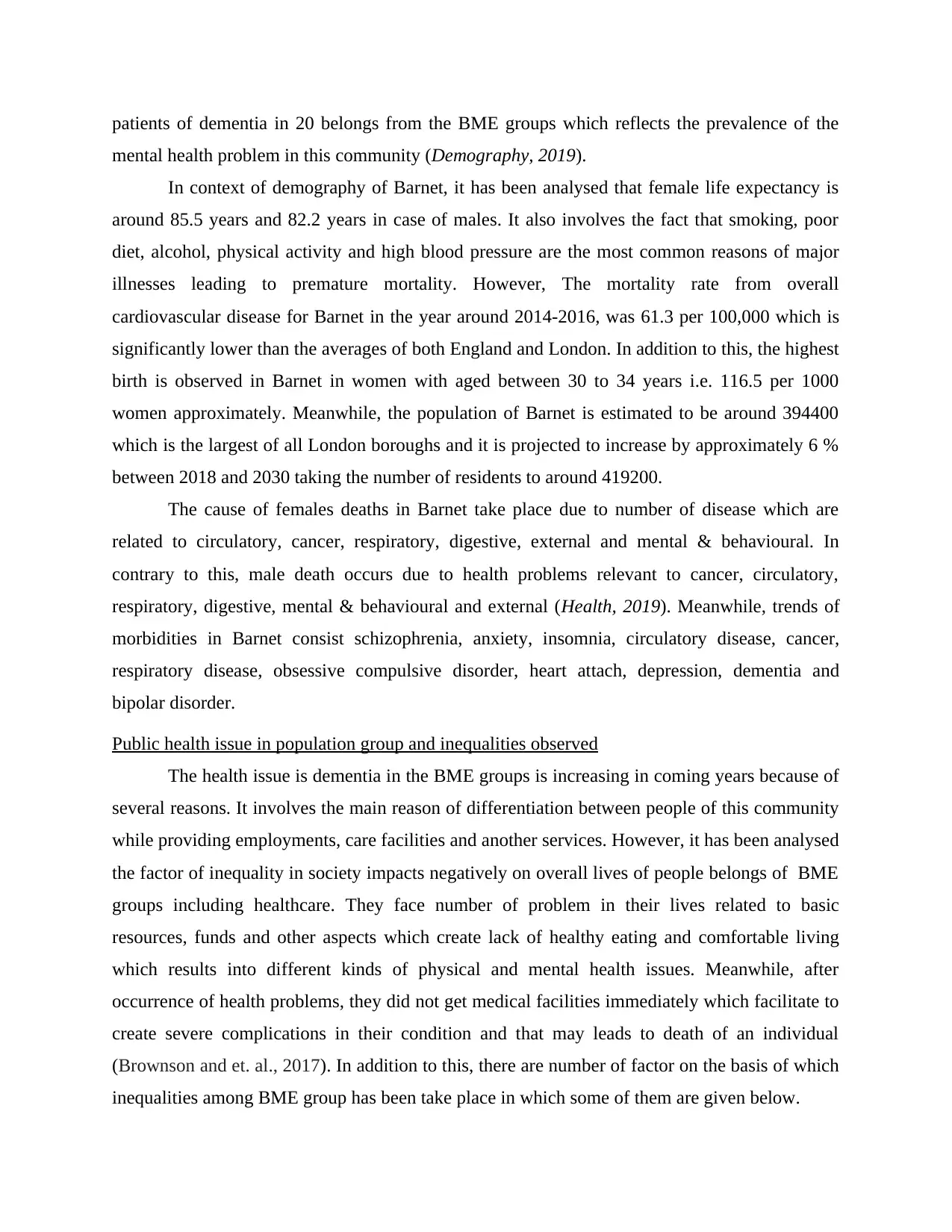
patients of dementia in 20 belongs from the BME groups which reflects the prevalence of the
mental health problem in this community (Demography, 2019).
In context of demography of Barnet, it has been analysed that female life expectancy is
around 85.5 years and 82.2 years in case of males. It also involves the fact that smoking, poor
diet, alcohol, physical activity and high blood pressure are the most common reasons of major
illnesses leading to premature mortality. However, The mortality rate from overall
cardiovascular disease for Barnet in the year around 2014-2016, was 61.3 per 100,000 which is
significantly lower than the averages of both England and London. In addition to this, the highest
birth is observed in Barnet in women with aged between 30 to 34 years i.e. 116.5 per 1000
women approximately. Meanwhile, the population of Barnet is estimated to be around 394400
which is the largest of all London boroughs and it is projected to increase by approximately 6 %
between 2018 and 2030 taking the number of residents to around 419200.
The cause of females deaths in Barnet take place due to number of disease which are
related to circulatory, cancer, respiratory, digestive, external and mental & behavioural. In
contrary to this, male death occurs due to health problems relevant to cancer, circulatory,
respiratory, digestive, mental & behavioural and external (Health, 2019). Meanwhile, trends of
morbidities in Barnet consist schizophrenia, anxiety, insomnia, circulatory disease, cancer,
respiratory disease, obsessive compulsive disorder, heart attach, depression, dementia and
bipolar disorder.
Public health issue in population group and inequalities observed
The health issue is dementia in the BME groups is increasing in coming years because of
several reasons. It involves the main reason of differentiation between people of this community
while providing employments, care facilities and another services. However, it has been analysed
the factor of inequality in society impacts negatively on overall lives of people belongs of BME
groups including healthcare. They face number of problem in their lives related to basic
resources, funds and other aspects which create lack of healthy eating and comfortable living
which results into different kinds of physical and mental health issues. Meanwhile, after
occurrence of health problems, they did not get medical facilities immediately which facilitate to
create severe complications in their condition and that may leads to death of an individual
(Brownson and et. al., 2017). In addition to this, there are number of factor on the basis of which
inequalities among BME group has been take place in which some of them are given below.
mental health problem in this community (Demography, 2019).
In context of demography of Barnet, it has been analysed that female life expectancy is
around 85.5 years and 82.2 years in case of males. It also involves the fact that smoking, poor
diet, alcohol, physical activity and high blood pressure are the most common reasons of major
illnesses leading to premature mortality. However, The mortality rate from overall
cardiovascular disease for Barnet in the year around 2014-2016, was 61.3 per 100,000 which is
significantly lower than the averages of both England and London. In addition to this, the highest
birth is observed in Barnet in women with aged between 30 to 34 years i.e. 116.5 per 1000
women approximately. Meanwhile, the population of Barnet is estimated to be around 394400
which is the largest of all London boroughs and it is projected to increase by approximately 6 %
between 2018 and 2030 taking the number of residents to around 419200.
The cause of females deaths in Barnet take place due to number of disease which are
related to circulatory, cancer, respiratory, digestive, external and mental & behavioural. In
contrary to this, male death occurs due to health problems relevant to cancer, circulatory,
respiratory, digestive, mental & behavioural and external (Health, 2019). Meanwhile, trends of
morbidities in Barnet consist schizophrenia, anxiety, insomnia, circulatory disease, cancer,
respiratory disease, obsessive compulsive disorder, heart attach, depression, dementia and
bipolar disorder.
Public health issue in population group and inequalities observed
The health issue is dementia in the BME groups is increasing in coming years because of
several reasons. It involves the main reason of differentiation between people of this community
while providing employments, care facilities and another services. However, it has been analysed
the factor of inequality in society impacts negatively on overall lives of people belongs of BME
groups including healthcare. They face number of problem in their lives related to basic
resources, funds and other aspects which create lack of healthy eating and comfortable living
which results into different kinds of physical and mental health issues. Meanwhile, after
occurrence of health problems, they did not get medical facilities immediately which facilitate to
create severe complications in their condition and that may leads to death of an individual
(Brownson and et. al., 2017). In addition to this, there are number of factor on the basis of which
inequalities among BME group has been take place in which some of them are given below.
Paraphrase This Document
Need a fresh take? Get an instant paraphrase of this document with our AI Paraphraser
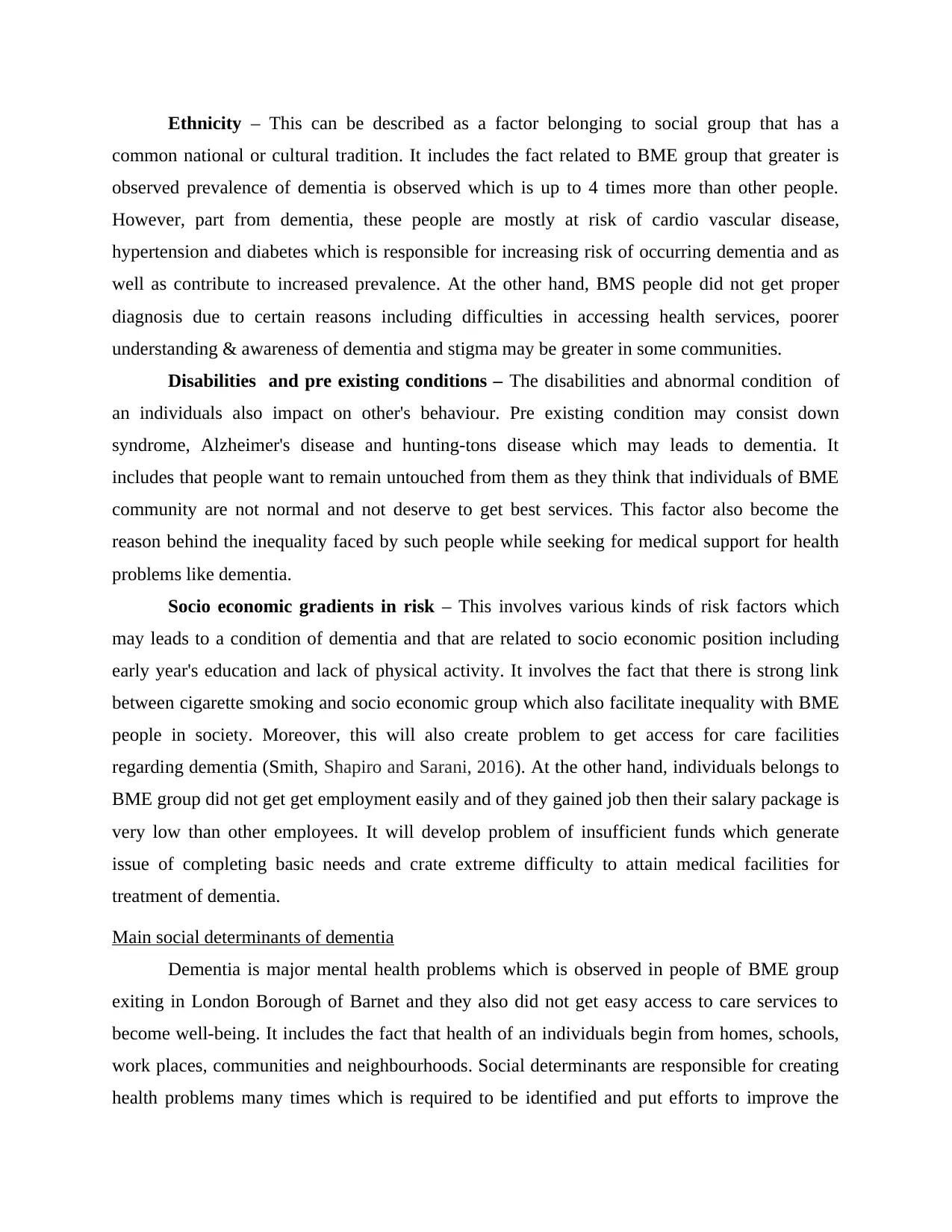
Ethnicity – This can be described as a factor belonging to social group that has a
common national or cultural tradition. It includes the fact related to BME group that greater is
observed prevalence of dementia is observed which is up to 4 times more than other people.
However, part from dementia, these people are mostly at risk of cardio vascular disease,
hypertension and diabetes which is responsible for increasing risk of occurring dementia and as
well as contribute to increased prevalence. At the other hand, BMS people did not get proper
diagnosis due to certain reasons including difficulties in accessing health services, poorer
understanding & awareness of dementia and stigma may be greater in some communities.
Disabilities and pre existing conditions – The disabilities and abnormal condition of
an individuals also impact on other's behaviour. Pre existing condition may consist down
syndrome, Alzheimer's disease and hunting-tons disease which may leads to dementia. It
includes that people want to remain untouched from them as they think that individuals of BME
community are not normal and not deserve to get best services. This factor also become the
reason behind the inequality faced by such people while seeking for medical support for health
problems like dementia.
Socio economic gradients in risk – This involves various kinds of risk factors which
may leads to a condition of dementia and that are related to socio economic position including
early year's education and lack of physical activity. It involves the fact that there is strong link
between cigarette smoking and socio economic group which also facilitate inequality with BME
people in society. Moreover, this will also create problem to get access for care facilities
regarding dementia (Smith, Shapiro and Sarani, 2016). At the other hand, individuals belongs to
BME group did not get get employment easily and of they gained job then their salary package is
very low than other employees. It will develop problem of insufficient funds which generate
issue of completing basic needs and crate extreme difficulty to attain medical facilities for
treatment of dementia.
Main social determinants of dementia
Dementia is major mental health problems which is observed in people of BME group
exiting in London Borough of Barnet and they also did not get easy access to care services to
become well-being. It includes the fact that health of an individuals begin from homes, schools,
work places, communities and neighbourhoods. Social determinants are responsible for creating
health problems many times which is required to be identified and put efforts to improve the
common national or cultural tradition. It includes the fact related to BME group that greater is
observed prevalence of dementia is observed which is up to 4 times more than other people.
However, part from dementia, these people are mostly at risk of cardio vascular disease,
hypertension and diabetes which is responsible for increasing risk of occurring dementia and as
well as contribute to increased prevalence. At the other hand, BMS people did not get proper
diagnosis due to certain reasons including difficulties in accessing health services, poorer
understanding & awareness of dementia and stigma may be greater in some communities.
Disabilities and pre existing conditions – The disabilities and abnormal condition of
an individuals also impact on other's behaviour. Pre existing condition may consist down
syndrome, Alzheimer's disease and hunting-tons disease which may leads to dementia. It
includes that people want to remain untouched from them as they think that individuals of BME
community are not normal and not deserve to get best services. This factor also become the
reason behind the inequality faced by such people while seeking for medical support for health
problems like dementia.
Socio economic gradients in risk – This involves various kinds of risk factors which
may leads to a condition of dementia and that are related to socio economic position including
early year's education and lack of physical activity. It involves the fact that there is strong link
between cigarette smoking and socio economic group which also facilitate inequality with BME
people in society. Moreover, this will also create problem to get access for care facilities
regarding dementia (Smith, Shapiro and Sarani, 2016). At the other hand, individuals belongs to
BME group did not get get employment easily and of they gained job then their salary package is
very low than other employees. It will develop problem of insufficient funds which generate
issue of completing basic needs and crate extreme difficulty to attain medical facilities for
treatment of dementia.
Main social determinants of dementia
Dementia is major mental health problems which is observed in people of BME group
exiting in London Borough of Barnet and they also did not get easy access to care services to
become well-being. It includes the fact that health of an individuals begin from homes, schools,
work places, communities and neighbourhoods. Social determinants are responsible for creating
health problems many times which is required to be identified and put efforts to improve the
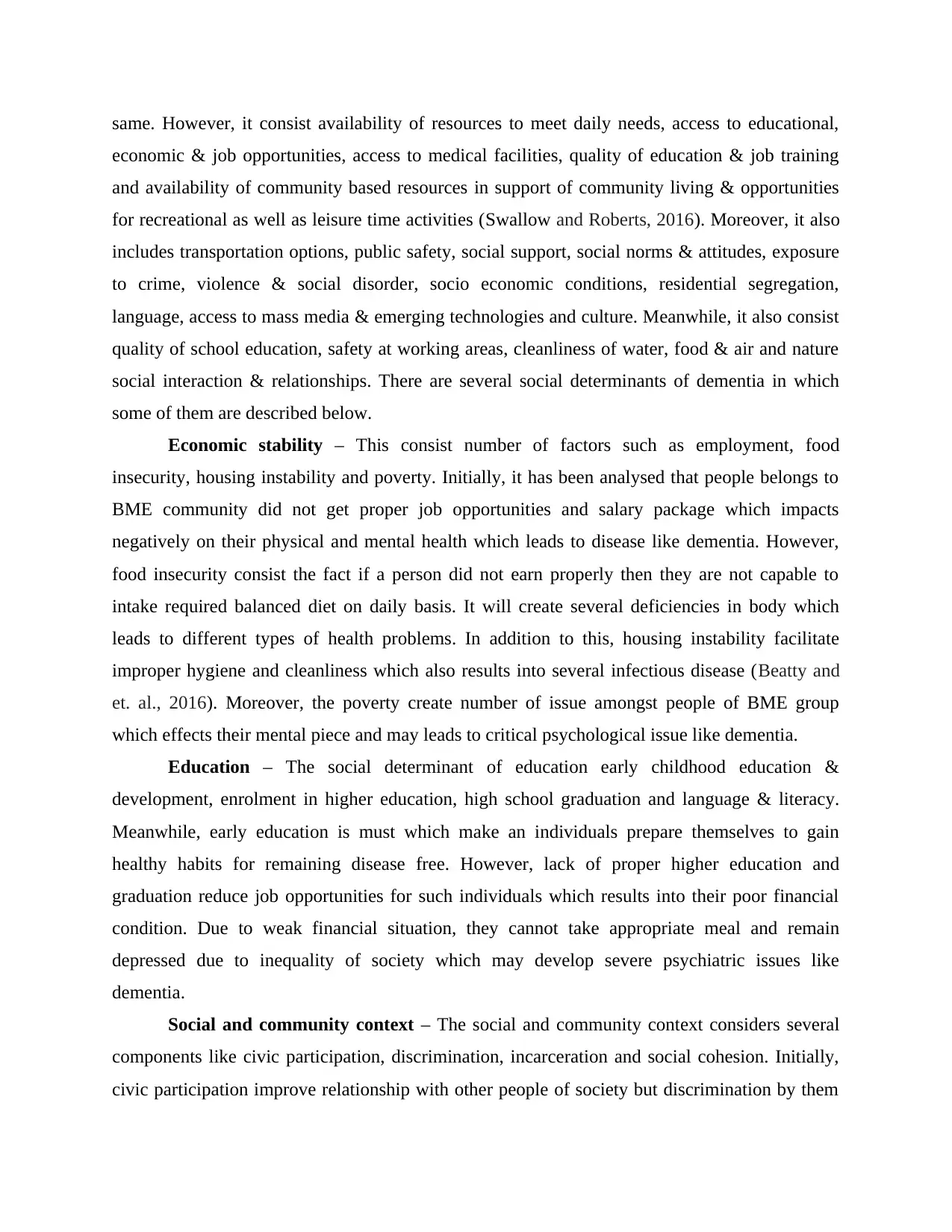
same. However, it consist availability of resources to meet daily needs, access to educational,
economic & job opportunities, access to medical facilities, quality of education & job training
and availability of community based resources in support of community living & opportunities
for recreational as well as leisure time activities (Swallow and Roberts, 2016). Moreover, it also
includes transportation options, public safety, social support, social norms & attitudes, exposure
to crime, violence & social disorder, socio economic conditions, residential segregation,
language, access to mass media & emerging technologies and culture. Meanwhile, it also consist
quality of school education, safety at working areas, cleanliness of water, food & air and nature
social interaction & relationships. There are several social determinants of dementia in which
some of them are described below.
Economic stability – This consist number of factors such as employment, food
insecurity, housing instability and poverty. Initially, it has been analysed that people belongs to
BME community did not get proper job opportunities and salary package which impacts
negatively on their physical and mental health which leads to disease like dementia. However,
food insecurity consist the fact if a person did not earn properly then they are not capable to
intake required balanced diet on daily basis. It will create several deficiencies in body which
leads to different types of health problems. In addition to this, housing instability facilitate
improper hygiene and cleanliness which also results into several infectious disease (Beatty and
et. al., 2016). Moreover, the poverty create number of issue amongst people of BME group
which effects their mental piece and may leads to critical psychological issue like dementia.
Education – The social determinant of education early childhood education &
development, enrolment in higher education, high school graduation and language & literacy.
Meanwhile, early education is must which make an individuals prepare themselves to gain
healthy habits for remaining disease free. However, lack of proper higher education and
graduation reduce job opportunities for such individuals which results into their poor financial
condition. Due to weak financial situation, they cannot take appropriate meal and remain
depressed due to inequality of society which may develop severe psychiatric issues like
dementia.
Social and community context – The social and community context considers several
components like civic participation, discrimination, incarceration and social cohesion. Initially,
civic participation improve relationship with other people of society but discrimination by them
economic & job opportunities, access to medical facilities, quality of education & job training
and availability of community based resources in support of community living & opportunities
for recreational as well as leisure time activities (Swallow and Roberts, 2016). Moreover, it also
includes transportation options, public safety, social support, social norms & attitudes, exposure
to crime, violence & social disorder, socio economic conditions, residential segregation,
language, access to mass media & emerging technologies and culture. Meanwhile, it also consist
quality of school education, safety at working areas, cleanliness of water, food & air and nature
social interaction & relationships. There are several social determinants of dementia in which
some of them are described below.
Economic stability – This consist number of factors such as employment, food
insecurity, housing instability and poverty. Initially, it has been analysed that people belongs to
BME community did not get proper job opportunities and salary package which impacts
negatively on their physical and mental health which leads to disease like dementia. However,
food insecurity consist the fact if a person did not earn properly then they are not capable to
intake required balanced diet on daily basis. It will create several deficiencies in body which
leads to different types of health problems. In addition to this, housing instability facilitate
improper hygiene and cleanliness which also results into several infectious disease (Beatty and
et. al., 2016). Moreover, the poverty create number of issue amongst people of BME group
which effects their mental piece and may leads to critical psychological issue like dementia.
Education – The social determinant of education early childhood education &
development, enrolment in higher education, high school graduation and language & literacy.
Meanwhile, early education is must which make an individuals prepare themselves to gain
healthy habits for remaining disease free. However, lack of proper higher education and
graduation reduce job opportunities for such individuals which results into their poor financial
condition. Due to weak financial situation, they cannot take appropriate meal and remain
depressed due to inequality of society which may develop severe psychiatric issues like
dementia.
Social and community context – The social and community context considers several
components like civic participation, discrimination, incarceration and social cohesion. Initially,
civic participation improve relationship with other people of society but discrimination by them
⊘ This is a preview!⊘
Do you want full access?
Subscribe today to unlock all pages.

Trusted by 1+ million students worldwide
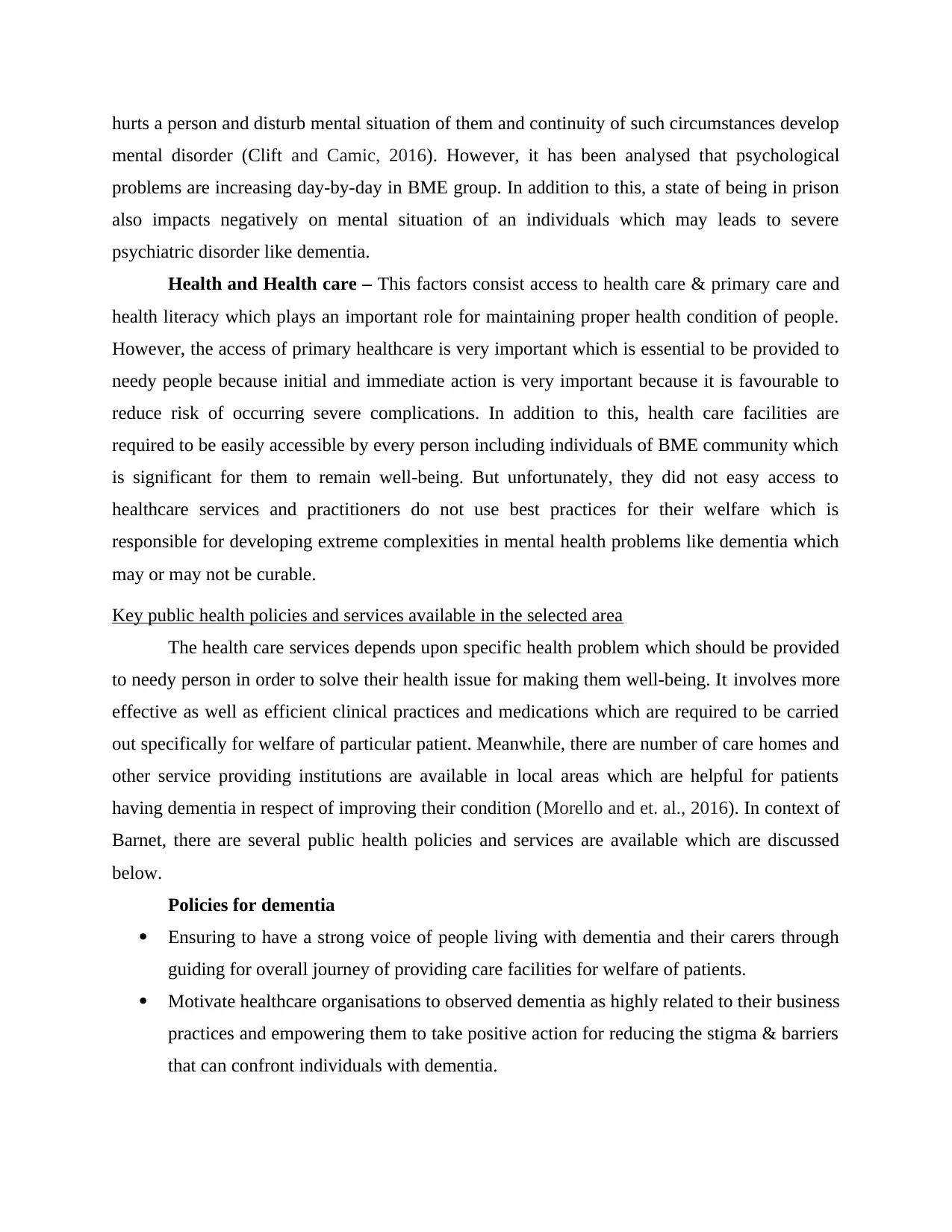
hurts a person and disturb mental situation of them and continuity of such circumstances develop
mental disorder (Clift and Camic, 2016). However, it has been analysed that psychological
problems are increasing day-by-day in BME group. In addition to this, a state of being in prison
also impacts negatively on mental situation of an individuals which may leads to severe
psychiatric disorder like dementia.
Health and Health care – This factors consist access to health care & primary care and
health literacy which plays an important role for maintaining proper health condition of people.
However, the access of primary healthcare is very important which is essential to be provided to
needy people because initial and immediate action is very important because it is favourable to
reduce risk of occurring severe complications. In addition to this, health care facilities are
required to be easily accessible by every person including individuals of BME community which
is significant for them to remain well-being. But unfortunately, they did not easy access to
healthcare services and practitioners do not use best practices for their welfare which is
responsible for developing extreme complexities in mental health problems like dementia which
may or may not be curable.
Key public health policies and services available in the selected area
The health care services depends upon specific health problem which should be provided
to needy person in order to solve their health issue for making them well-being. It involves more
effective as well as efficient clinical practices and medications which are required to be carried
out specifically for welfare of particular patient. Meanwhile, there are number of care homes and
other service providing institutions are available in local areas which are helpful for patients
having dementia in respect of improving their condition (Morello and et. al., 2016). In context of
Barnet, there are several public health policies and services are available which are discussed
below.
Policies for dementia
Ensuring to have a strong voice of people living with dementia and their carers through
guiding for overall journey of providing care facilities for welfare of patients.
Motivate healthcare organisations to observed dementia as highly related to their business
practices and empowering them to take positive action for reducing the stigma & barriers
that can confront individuals with dementia.
mental disorder (Clift and Camic, 2016). However, it has been analysed that psychological
problems are increasing day-by-day in BME group. In addition to this, a state of being in prison
also impacts negatively on mental situation of an individuals which may leads to severe
psychiatric disorder like dementia.
Health and Health care – This factors consist access to health care & primary care and
health literacy which plays an important role for maintaining proper health condition of people.
However, the access of primary healthcare is very important which is essential to be provided to
needy people because initial and immediate action is very important because it is favourable to
reduce risk of occurring severe complications. In addition to this, health care facilities are
required to be easily accessible by every person including individuals of BME community which
is significant for them to remain well-being. But unfortunately, they did not easy access to
healthcare services and practitioners do not use best practices for their welfare which is
responsible for developing extreme complexities in mental health problems like dementia which
may or may not be curable.
Key public health policies and services available in the selected area
The health care services depends upon specific health problem which should be provided
to needy person in order to solve their health issue for making them well-being. It involves more
effective as well as efficient clinical practices and medications which are required to be carried
out specifically for welfare of particular patient. Meanwhile, there are number of care homes and
other service providing institutions are available in local areas which are helpful for patients
having dementia in respect of improving their condition (Morello and et. al., 2016). In context of
Barnet, there are several public health policies and services are available which are discussed
below.
Policies for dementia
Ensuring to have a strong voice of people living with dementia and their carers through
guiding for overall journey of providing care facilities for welfare of patients.
Motivate healthcare organisations to observed dementia as highly related to their business
practices and empowering them to take positive action for reducing the stigma & barriers
that can confront individuals with dementia.
Paraphrase This Document
Need a fresh take? Get an instant paraphrase of this document with our AI Paraphraser
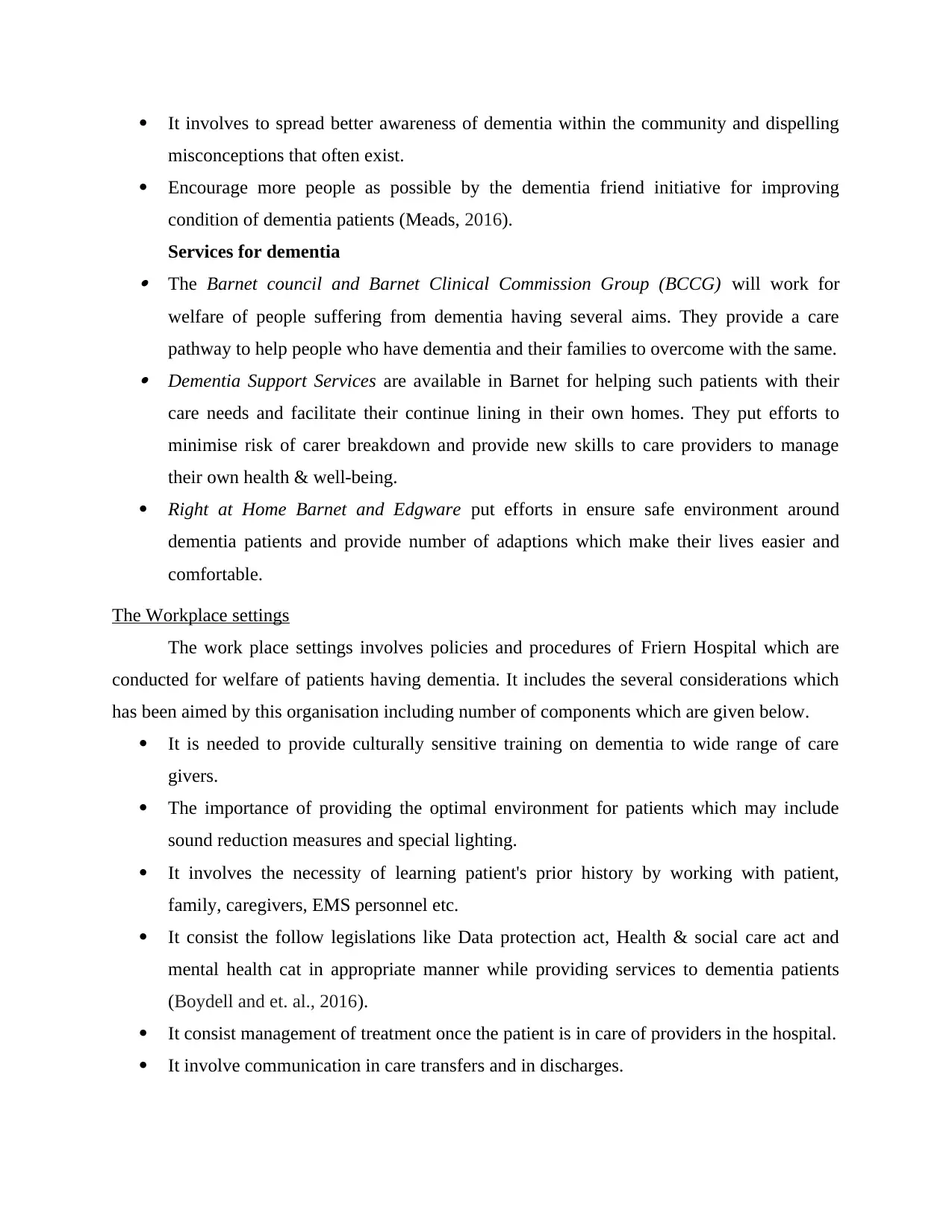
It involves to spread better awareness of dementia within the community and dispelling
misconceptions that often exist.
Encourage more people as possible by the dementia friend initiative for improving
condition of dementia patients (Meads, 2016).
Services for dementia The Barnet council and Barnet Clinical Commission Group (BCCG) will work for
welfare of people suffering from dementia having several aims. They provide a care
pathway to help people who have dementia and their families to overcome with the same. Dementia Support Services are available in Barnet for helping such patients with their
care needs and facilitate their continue lining in their own homes. They put efforts to
minimise risk of carer breakdown and provide new skills to care providers to manage
their own health & well-being.
Right at Home Barnet and Edgware put efforts in ensure safe environment around
dementia patients and provide number of adaptions which make their lives easier and
comfortable.
The Workplace settings
The work place settings involves policies and procedures of Friern Hospital which are
conducted for welfare of patients having dementia. It includes the several considerations which
has been aimed by this organisation including number of components which are given below.
It is needed to provide culturally sensitive training on dementia to wide range of care
givers.
The importance of providing the optimal environment for patients which may include
sound reduction measures and special lighting.
It involves the necessity of learning patient's prior history by working with patient,
family, caregivers, EMS personnel etc.
It consist the follow legislations like Data protection act, Health & social care act and
mental health cat in appropriate manner while providing services to dementia patients
(Boydell and et. al., 2016).
It consist management of treatment once the patient is in care of providers in the hospital.
It involve communication in care transfers and in discharges.
misconceptions that often exist.
Encourage more people as possible by the dementia friend initiative for improving
condition of dementia patients (Meads, 2016).
Services for dementia The Barnet council and Barnet Clinical Commission Group (BCCG) will work for
welfare of people suffering from dementia having several aims. They provide a care
pathway to help people who have dementia and their families to overcome with the same. Dementia Support Services are available in Barnet for helping such patients with their
care needs and facilitate their continue lining in their own homes. They put efforts to
minimise risk of carer breakdown and provide new skills to care providers to manage
their own health & well-being.
Right at Home Barnet and Edgware put efforts in ensure safe environment around
dementia patients and provide number of adaptions which make their lives easier and
comfortable.
The Workplace settings
The work place settings involves policies and procedures of Friern Hospital which are
conducted for welfare of patients having dementia. It includes the several considerations which
has been aimed by this organisation including number of components which are given below.
It is needed to provide culturally sensitive training on dementia to wide range of care
givers.
The importance of providing the optimal environment for patients which may include
sound reduction measures and special lighting.
It involves the necessity of learning patient's prior history by working with patient,
family, caregivers, EMS personnel etc.
It consist the follow legislations like Data protection act, Health & social care act and
mental health cat in appropriate manner while providing services to dementia patients
(Boydell and et. al., 2016).
It consist management of treatment once the patient is in care of providers in the hospital.
It involve communication in care transfers and in discharges.
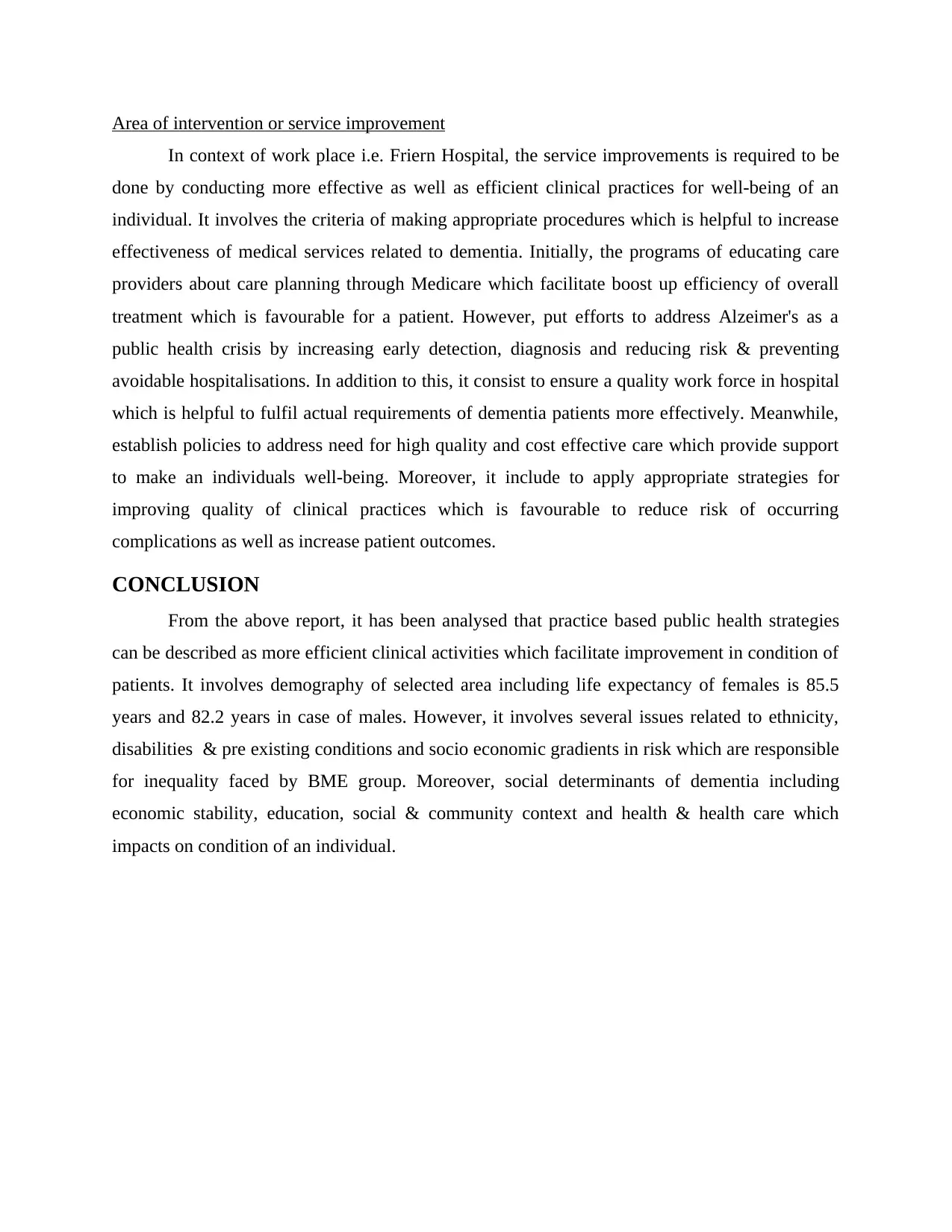
Area of intervention or service improvement
In context of work place i.e. Friern Hospital, the service improvements is required to be
done by conducting more effective as well as efficient clinical practices for well-being of an
individual. It involves the criteria of making appropriate procedures which is helpful to increase
effectiveness of medical services related to dementia. Initially, the programs of educating care
providers about care planning through Medicare which facilitate boost up efficiency of overall
treatment which is favourable for a patient. However, put efforts to address Alzeimer's as a
public health crisis by increasing early detection, diagnosis and reducing risk & preventing
avoidable hospitalisations. In addition to this, it consist to ensure a quality work force in hospital
which is helpful to fulfil actual requirements of dementia patients more effectively. Meanwhile,
establish policies to address need for high quality and cost effective care which provide support
to make an individuals well-being. Moreover, it include to apply appropriate strategies for
improving quality of clinical practices which is favourable to reduce risk of occurring
complications as well as increase patient outcomes.
CONCLUSION
From the above report, it has been analysed that practice based public health strategies
can be described as more efficient clinical activities which facilitate improvement in condition of
patients. It involves demography of selected area including life expectancy of females is 85.5
years and 82.2 years in case of males. However, it involves several issues related to ethnicity,
disabilities & pre existing conditions and socio economic gradients in risk which are responsible
for inequality faced by BME group. Moreover, social determinants of dementia including
economic stability, education, social & community context and health & health care which
impacts on condition of an individual.
In context of work place i.e. Friern Hospital, the service improvements is required to be
done by conducting more effective as well as efficient clinical practices for well-being of an
individual. It involves the criteria of making appropriate procedures which is helpful to increase
effectiveness of medical services related to dementia. Initially, the programs of educating care
providers about care planning through Medicare which facilitate boost up efficiency of overall
treatment which is favourable for a patient. However, put efforts to address Alzeimer's as a
public health crisis by increasing early detection, diagnosis and reducing risk & preventing
avoidable hospitalisations. In addition to this, it consist to ensure a quality work force in hospital
which is helpful to fulfil actual requirements of dementia patients more effectively. Meanwhile,
establish policies to address need for high quality and cost effective care which provide support
to make an individuals well-being. Moreover, it include to apply appropriate strategies for
improving quality of clinical practices which is favourable to reduce risk of occurring
complications as well as increase patient outcomes.
CONCLUSION
From the above report, it has been analysed that practice based public health strategies
can be described as more efficient clinical activities which facilitate improvement in condition of
patients. It involves demography of selected area including life expectancy of females is 85.5
years and 82.2 years in case of males. However, it involves several issues related to ethnicity,
disabilities & pre existing conditions and socio economic gradients in risk which are responsible
for inequality faced by BME group. Moreover, social determinants of dementia including
economic stability, education, social & community context and health & health care which
impacts on condition of an individual.
⊘ This is a preview!⊘
Do you want full access?
Subscribe today to unlock all pages.

Trusted by 1+ million students worldwide
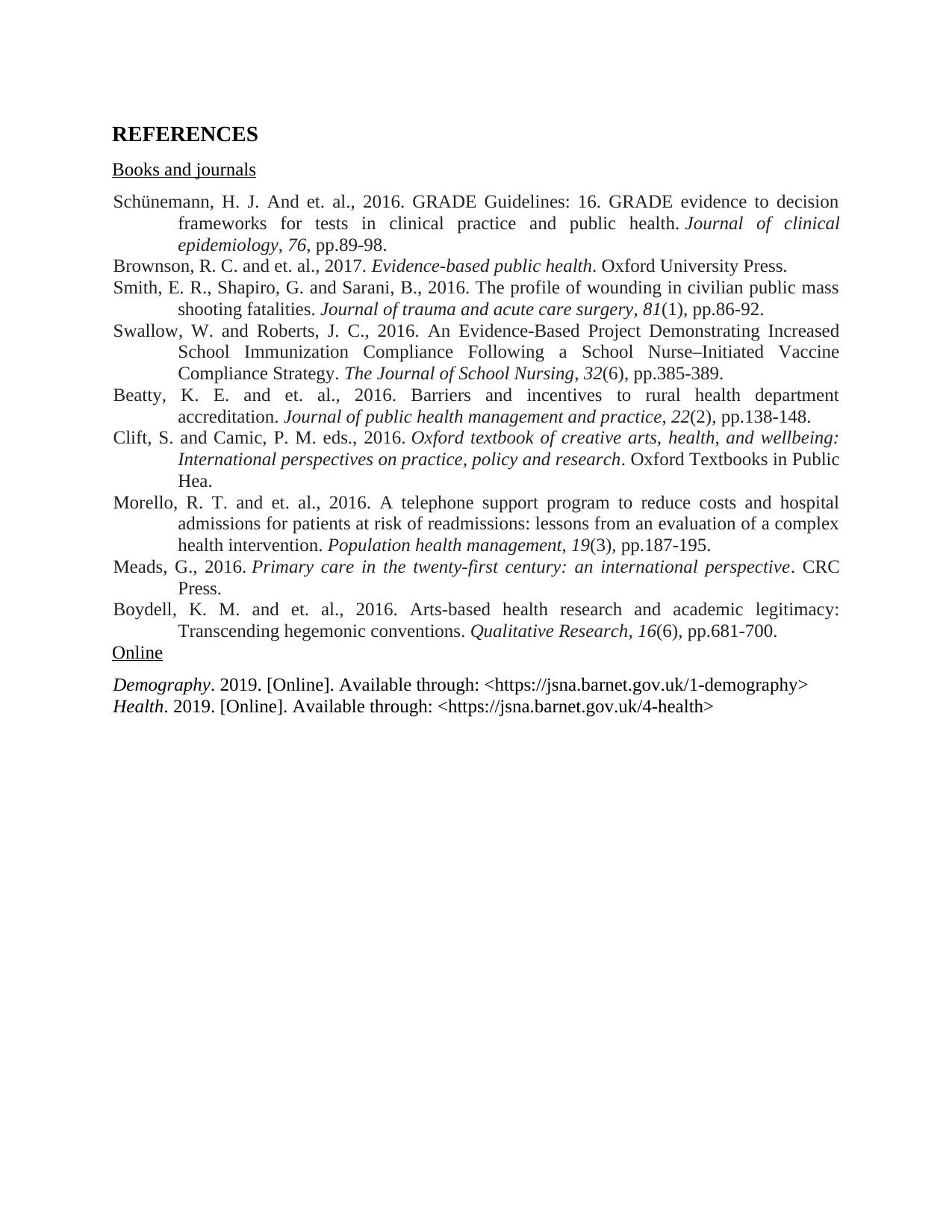
REFERENCES
Books and journals
Schünemann, H. J. And et. al., 2016. GRADE Guidelines: 16. GRADE evidence to decision
frameworks for tests in clinical practice and public health. Journal of clinical
epidemiology, 76, pp.89-98.
Brownson, R. C. and et. al., 2017. Evidence-based public health. Oxford University Press.
Smith, E. R., Shapiro, G. and Sarani, B., 2016. The profile of wounding in civilian public mass
shooting fatalities. Journal of trauma and acute care surgery, 81(1), pp.86-92.
Swallow, W. and Roberts, J. C., 2016. An Evidence-Based Project Demonstrating Increased
School Immunization Compliance Following a School Nurse–Initiated Vaccine
Compliance Strategy. The Journal of School Nursing, 32(6), pp.385-389.
Beatty, K. E. and et. al., 2016. Barriers and incentives to rural health department
accreditation. Journal of public health management and practice, 22(2), pp.138-148.
Clift, S. and Camic, P. M. eds., 2016. Oxford textbook of creative arts, health, and wellbeing:
International perspectives on practice, policy and research. Oxford Textbooks in Public
Hea.
Morello, R. T. and et. al., 2016. A telephone support program to reduce costs and hospital
admissions for patients at risk of readmissions: lessons from an evaluation of a complex
health intervention. Population health management, 19(3), pp.187-195.
Meads, G., 2016. Primary care in the twenty-first century: an international perspective. CRC
Press.
Boydell, K. M. and et. al., 2016. Arts-based health research and academic legitimacy:
Transcending hegemonic conventions. Qualitative Research, 16(6), pp.681-700.
Online
Demography. 2019. [Online]. Available through: <https://jsna.barnet.gov.uk/1-demography>
Health. 2019. [Online]. Available through: <https://jsna.barnet.gov.uk/4-health>
Books and journals
Schünemann, H. J. And et. al., 2016. GRADE Guidelines: 16. GRADE evidence to decision
frameworks for tests in clinical practice and public health. Journal of clinical
epidemiology, 76, pp.89-98.
Brownson, R. C. and et. al., 2017. Evidence-based public health. Oxford University Press.
Smith, E. R., Shapiro, G. and Sarani, B., 2016. The profile of wounding in civilian public mass
shooting fatalities. Journal of trauma and acute care surgery, 81(1), pp.86-92.
Swallow, W. and Roberts, J. C., 2016. An Evidence-Based Project Demonstrating Increased
School Immunization Compliance Following a School Nurse–Initiated Vaccine
Compliance Strategy. The Journal of School Nursing, 32(6), pp.385-389.
Beatty, K. E. and et. al., 2016. Barriers and incentives to rural health department
accreditation. Journal of public health management and practice, 22(2), pp.138-148.
Clift, S. and Camic, P. M. eds., 2016. Oxford textbook of creative arts, health, and wellbeing:
International perspectives on practice, policy and research. Oxford Textbooks in Public
Hea.
Morello, R. T. and et. al., 2016. A telephone support program to reduce costs and hospital
admissions for patients at risk of readmissions: lessons from an evaluation of a complex
health intervention. Population health management, 19(3), pp.187-195.
Meads, G., 2016. Primary care in the twenty-first century: an international perspective. CRC
Press.
Boydell, K. M. and et. al., 2016. Arts-based health research and academic legitimacy:
Transcending hegemonic conventions. Qualitative Research, 16(6), pp.681-700.
Online
Demography. 2019. [Online]. Available through: <https://jsna.barnet.gov.uk/1-demography>
Health. 2019. [Online]. Available through: <https://jsna.barnet.gov.uk/4-health>
1 out of 10
Related Documents
Your All-in-One AI-Powered Toolkit for Academic Success.
+13062052269
info@desklib.com
Available 24*7 on WhatsApp / Email
![[object Object]](/_next/static/media/star-bottom.7253800d.svg)
Unlock your academic potential
Copyright © 2020–2025 A2Z Services. All Rights Reserved. Developed and managed by ZUCOL.




